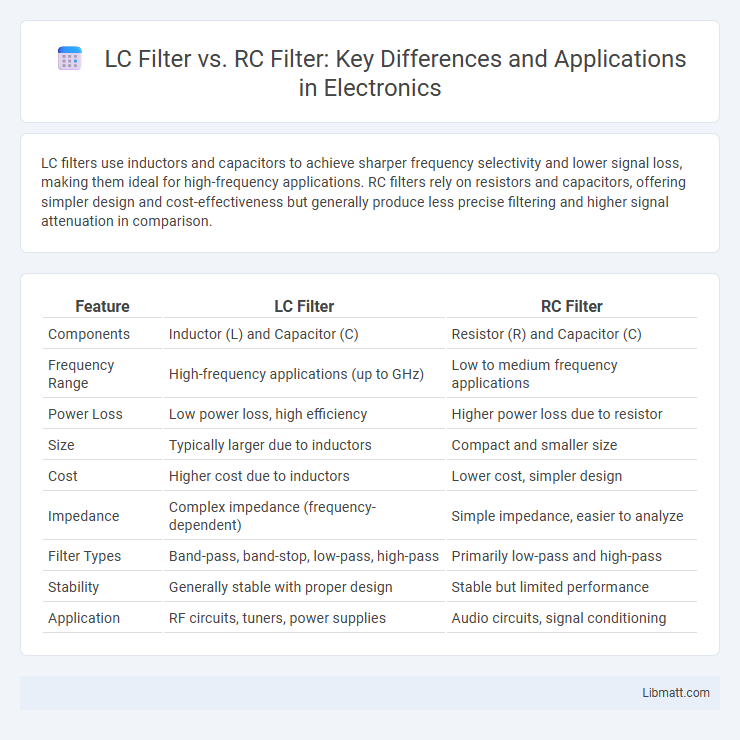LC filters use inductors and capacitors to achieve sharper frequency selectivity and lower signal loss, making them ideal for high-frequency applications. RC filters rely on resistors and capacitors, offering simpler design and cost-effectiveness but generally produce less precise filtering and higher signal attenuation in comparison.
Table of Comparison
| Feature | LC Filter | RC Filter |
|---|---|---|
| Components | Inductor (L) and Capacitor (C) | Resistor (R) and Capacitor (C) |
| Frequency Range | High-frequency applications (up to GHz) | Low to medium frequency applications |
| Power Loss | Low power loss, high efficiency | Higher power loss due to resistor |
| Size | Typically larger due to inductors | Compact and smaller size |
| Cost | Higher cost due to inductors | Lower cost, simpler design |
| Impedance | Complex impedance (frequency-dependent) | Simple impedance, easier to analyze |
| Filter Types | Band-pass, band-stop, low-pass, high-pass | Primarily low-pass and high-pass |
| Stability | Generally stable with proper design | Stable but limited performance |
| Application | RF circuits, tuners, power supplies | Audio circuits, signal conditioning |
Introduction to LC and RC Filters
LC filters use inductors (L) and capacitors (C) to create resonant circuits that selectively pass or block specific frequency ranges, offering high Q-factor and efficient frequency selectivity. RC filters, composed of resistors (R) and capacitors (C), provide simpler, cost-effective frequency filtering with lower Q-factor and are commonly used in audio and signal processing applications. LC filters are preferred for sharper cutoff and higher power handling, while RC filters excel in low-frequency and small-signal scenarios.
Basic Working Principle of LC Filters
LC filters operate by combining inductors and capacitors to selectively pass or block specific frequency ranges based on their resonant properties. Inductors store energy in a magnetic field, opposing changes in current, while capacitors store energy in an electric field, opposing changes in voltage, allowing LC filters to achieve sharper frequency selectivity and lower signal loss compared to RC filters. Your choice of an LC filter enhances performance where precise frequency separation and minimal insertion loss are crucial.
Basic Working Principle of RC Filters
RC filters operate by using a resistor and capacitor to control frequency response, where the capacitor stores and releases energy to block or pass signals based on their frequency. The resistor limits the current flow, creating a voltage drop that, combined with the capacitor's impedance, determines the cutoff frequency. This configuration allows RC filters to effectively separate signals into high-pass or low-pass categories depending on component arrangement.
Key Differences Between LC and RC Filters
LC filters use inductors and capacitors to achieve sharper frequency selectivity and higher quality factor (Q) compared to RC filters, which utilize resistors and capacitors. LC filters offer lower signal loss and better performance at high frequencies, making them ideal for RF and communications applications. RC filters, being simpler and cheaper, are more suitable for low-frequency applications but suffer from lower selectivity and higher attenuation.
Frequency Response Comparison
LC filters offer sharper frequency response with steeper roll-off rates compared to RC filters, making them ideal for precise signal separation in high-frequency applications. RC filters exhibit a more gradual attenuation and are simpler but less effective for high-frequency signals due to their limited selectivity and higher signal loss. Your choice between LC and RC filters impacts the effectiveness of frequency discrimination based on the specific bandwidth and response requirements in your electronic circuit design.
Applications of LC Filters
LC filters are widely used in radio frequency (RF) applications, such as transmitter and receiver circuits, due to their superior selectivity and lower insertion loss compared to RC filters. They are essential in power supply systems for smoothing voltage and reducing electromagnetic interference (EMI). Additionally, LC filters are preferred in audio crossover networks to separate frequency bands with high precision.
Applications of RC Filters
RC filters are widely used in audio signal processing, low-frequency noise reduction, and simple DC voltage smoothing due to their cost-effectiveness and ease of implementation. You will find RC filters in tone controls, crossover networks in speakers, and in analog circuits where moderate frequency selectivity suffices. Their simplicity makes them ideal for applications requiring basic filtering without the complexity or size of inductors found in LC filters.
Advantages and Disadvantages of LC Filters
LC filters offer high efficiency in signal processing due to their low power loss and superior selectivity, making them ideal for applications requiring sharp frequency cutoffs and minimal distortion. Their advantages include the ability to handle high frequencies with minimal signal attenuation and improved quality factor (Q), while disadvantages involve larger physical size, higher cost, and sensitivity to component tolerances compared to RC filters. LC filters also exhibit inherent resonance properties that provide better performance for RF and audio applications but require careful design to avoid excessive ringing and stability issues.
Advantages and Disadvantages of RC Filters
RC filters offer simplicity, low cost, and easy integration in electronic circuits, making them ideal for low-frequency applications and signal conditioning. They exhibit higher signal distortion and power loss compared to LC filters, limiting their efficiency in high-frequency or high-precision filtering scenarios. The primary disadvantage is their inability to achieve sharp cutoff frequencies, which reduces their effectiveness in demanding filtering tasks where selectivity and low insertion loss are critical.
Choosing the Right Filter: LC vs RC
Choosing the right filter depends on your application's frequency response requirements: LC filters provide higher quality factor (Q) and sharper cutoff frequencies, making them ideal for radio frequency (RF) circuits and precise signal processing. RC filters are simpler, more cost-effective, and better suited for audio frequency or low-frequency applications where moderate filtering is sufficient. Your decision should consider factors like component size, power handling, and desired filter performance to ensure optimal results.
LC Filter vs RC Filter Infographic

 libmatt.com
libmatt.com